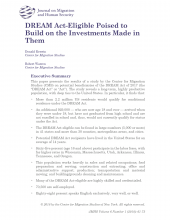DREAM Act-Eligible Poised to Build on the Investments Made in Them
Political debate has intensified over "Dreamers" -- immigrants who were brought to the United States as children without authorization. In this paper, Donald Kerwin and Robert Warren from the Center for Migration Studies argue that granting Dreamers a path to citizenship would capitalize on the educational investments already made in them and boost their already high economic productivity. Using data from the American Community Survey, the authors present a series of tables showing the size of the Dreamer population, money invested in them, connections to their community, labor force participation rates, occupations and likely countries of origin. In doing so, the authors also reveal how the Dreamer population is distributed around the country (at least 5,000 in each of 41 states) and how deeply integrated they are in U.S. life. Dreamers, for example, have above average labor force participation (65 percent) and English language proficiency (88 percent speak English exclusively, very well, or well). Citing a study that shows that a path to citizenship would also increase U.S. gross domestic product by $7.6 billion annually in the short-term, the authors call for legislation to achieve this goal. (Sakura Tomizawa for The Immigrant Learning Center Public Education Institute)
Kerwin, D., & Warren, R. (2018). DREAM Act-Eligible Poised to Build on the Investments Made in Them. Journal on Migration and Human Security, 6(1), 61–73. https://doi.org/10.14240/jmhs.v6i1.112

